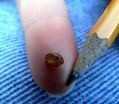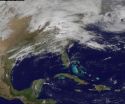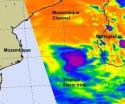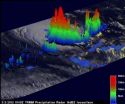(Press-News.org) BUFFALO, N.Y. -- Freshwater ecosystems in northern regions are home to significantly more species of water fleas than traditionally thought, adding to evidence that regions with vanishing waters contain unique animal life.
The new information on water fleas -- which are actually tiny crustaceans -- comes from a multi-year, international study that was published Feb. 24 in the journal Zootaxa.
The researchers scoured the globe seeking the creatures and found them inhabiting northern lakes and ponds in locations from Alaska to Russia to Scandinavia.
After analyzing the anatomy and genetic makeup of many different specimens, the team conclusively determined that at least 10 species of the crustaceans existed -- five times as many as thought for much of the last century.
More than half the diversity was found in northern latitudes, where rapid freshwater habitat loss is occurring due to melting permafrost, increased evaporation and other changes tied to climate change.
"It is well known that parts of Alaska and Siberia have suffered a huge reduction in freshwater surface area, with many lakes and ponds disappearing permanently in the past few decades," said Derek J. Taylor, a University at Buffalo biologist and member of the research team. "What we're now finding is that these regions with vanishing waters, while not the most diverse in the world, do contain some unique aquatic animals."
"Some of these subarctic ponds that water fleas inhabit are held up by permafrost, so when this lining of ice melts or cracks, it's like pulling the plug out of a sink," Taylor said. "When you see the crop-circle-like skeletons of drained ponds on the tundra you can't help but wonder what animal life has been lost here."
Taylor's colleagues on the study included Eugeniya I. Bekker and Alexey A. Kotov of the A. N. Severtsov Institute of Ecology and Evolution in Moscow.
The research focused on water fleas of the genus Eurycercus, which can reach lengths of about 6 millimeters. The findings add to a body of evidence suggesting that the species diversity of water fleas is greater in northern regions than in the tropics.
This is a counterintuitive concept, as scientists have long supposed that the advance and readvance of ice sheets reduced much of the species diversity in colder climates, Taylor said. However, there is growing evidence that some northern areas remained ice-free and acted as hideouts during the harsh glacial advances.
The researchers not only convincingly documented new species diversity, but identified one likely new species and provided a detailed, formal description of another: Eurycercus beringi.
Like other water fleas, E. beringi is an important source of nutrients for fish and aquatic birds.
The new species -- from Alaska's remote Seward Peninsula -- has unusual anatomical features that force a rewrite of the taxonomy of Eurycercus above the species level. Moreover, the new anatomical details should aid future studies that use preserved body parts of Eurycercus found in lake sediments to reconstruct past ecological conditions.
The discovery of new crustacean species in unexpected places underscores the scope of the ongoing biodiversity crisis for freshwater ecosystems.
INFORMATION:
Unexpected crustacean diversity discovered in northern freshwater ecosystems
A new species adds to evidence that subarctic regions with vanishing waters contain unique aquatic animals
2012-03-05
ELSE PRESS RELEASES FROM THIS DATE:
Better Hires, Faster, for Less Money - a Recruiting Solution That's Perfect for CEOs of Growing Companies
2012-03-05
FitzDrake Search (FDS) has crafted a unique hiring solution for small to medium firms poised for growth. Managing Partner Bill Fitzgerald notes "It is clear that growth in the economy will be from small and medium sized businesses. They become incubators for new ideas and innovations that lead to job creation." However, many of these firms do not always have the internal recruiting infrastructure to find top candidates quickly and at a reasonable cost. The FDS approach helps clients manage risk and preserve cash flow.
Unlike traditional retained or contingent ...
Notre Dame's Bengal Bouts participants aid in concussion research
2012-03-05
The University of Notre Dame's annual Bengal Bouts student boxing tournament's longtime mantra is "Strong Bodies Fight that Weak Bodies May Be Nourished."
The unusual mantra is fitting for an unusual competition whose ticket sales proceeds benefit Holy Cross Missions in Bangladesh, part of the ministry of the Congregation for the Holy Cross, Notre Dame's founding religious community.
However, this year a large number of Bengal Bouts boxers are going even further to do good by volunteering to participate in post-bout concussion testing.
James Moriarty, the University's ...
Heart-powered pacemaker could one day eliminate battery-replacement surgery
2012-03-05
ANN ARBOR, Mich.—A new power scheme for cardiac pacemakers turns to an unlikely source: vibrations from heartbeats themselves.
Engineering researchers at the University of Michigan designed a device that harvests energy from the reverberation of heartbeats through the chest and converts it to electricity to run a pacemaker or an implanted defibrillator. These mini-medical machines send electrical signals to the heart to keep it beating in a healthy rhythm. By taking the place of the batteries that power them today, the new energy harvester could save patients from repeated ...
Another severe weather system seen on satellite movie from NASA
2012-03-05
VIDEO:
This movie was created using GOES-13 visible and infrared satellite imagery. The 25 second movie runs from Feb. 29 at 1718 UTC (12:18 pm EST) through March 2 at 1740...
Click here for more information.
Another powerful weather system is moving through the central and eastern U.S., generating more severe weather. NASA created an animation of data from NOAA's GOES-13 satellite that shows the frontal system pushing east as it generated severe weather in Ohio, Kentucky, ...
Dark matter core defies explanation in NASA Hubble image
2012-03-05
Astronomers using data from NASA's Hubble Telescope have observed what appears to be a clump of dark matter left behind from a wreck between massive clusters of galaxies. The result could challenge current theories about dark matter that predict galaxies should be anchored to the invisible substance even during the shock of a collision.
Abell 520 is a gigantic merger of galaxy clusters located 2.4 billion light-years away. Dark matter is not visible, although its presence and distribution is found indirectly through its effects. Dark matter can act like a magnifying glass, ...
HollywoodSportsbook.eu Announces Its Own Unique March Madness Contest
2012-03-05
Hollywood Sportsbook (www.hollywoodsportsbook.eu) a leading online entertainment gaming site since 1997, today announced it will offer a month long promotion allowing players to pick the winners of certain NBA and college basketball games all month long.
Robert Evans, Hollywood's Director of Operations says, "Well here we are... the most exciting month for basketball. In addition to all the cool stuff we will have going on this month for the NCAA tournament, we hope this contest will float our players' boats as well..."
For each coming weekend in March, ...
NASA sees tropical storm Irina hit by wind shear, headed for Mozambique
2012-03-05
The AIRS instrument on NASA's Aqua satellite provided forecasters with an infrared look at what was happening "under the hood" of Tropical Storm Irina's clouds and saw two reasons why it temporarily weakened before moving into the Mozambique Channel and heading for landfall in Mozambique in a couple of days.
WHY DID IT WEAKEN?
NASA's Aqua satellite's Atmospheric Infrared Sounder (AIRS) instrument captured an infrared image of Tropical Cyclone Irina over the Mozambique Channel on March 1, 2012 at 0130 UTC (8:30 p.m. EST, Feb. 29). At that time, the strongest thunderstorms ...
NASA's TRMM satellite sees remnants of Tropical Cyclone 15S's 'difficult childhood'
2012-03-05
Tropical Cyclone 15S has had a difficult "childhood." It was born on March 1 and immediately dealt with a harsh environment. The cyclone weakened within 24 hours to a remnant low pressure area, and NASA's TRMM satellite revealed there was still some strength remaining in the storm.
The Tropical Rainfall Measuring Mission (TRMM) satellite passed over the remnants of Tropical Cyclone 15S in the South Indian Ocean on March 2, 2012 at 0140 UTC (8:40 p.m. EST, March 1). A rainfall analysis from TRMM's Microwave Imager (TMI) and Precipitation Radar (PR) instruments showed very ...
The future of plant science – a technology perspective
2012-03-05
Washington, D.C. -- Plant science is key to addressing the major challenges facing humanity in the 21st Century, according to Carnegie's David Ehrhardt and Wolf Frommer. In a Perspective published in The Plant Cell, the two researchers argue that the development of new technology is key to transforming plant biology in order to meet human needs.
Plants serve as the conduit of energy into the biosphere, provide food and materials used by humans, and they shape our environment. According to Ehrhardt and Frommer, the three major challenges facing humanity in our time are ...
When your ship comes in
2012-03-05
Every day, thousands of cargo containers from around the world pass through our nation's sea ports carrying items we need, and possibly some that are not so welcome: drugs, explosives, chemical, biological, or radiological weapons – even human cargo.
The possible concealment of such items in containers led lawmakers to call for the screening of all ocean cargo containers—thousands per port per day. The Department of Homeland Security's (DHS) U.S. Customs and Border Protection (CBP) is charged with the critical task of securing the country from terrorists and their ...
LAST 30 PRESS RELEASES:
The Ceramic Society of Japan’s Oxoate Ceramics Research Association launches new international book project
Heart-brain connection: international study reveals the role of the vagus nerve in keeping the heart young
Researchers identify Rb1 as a predictive biomarker for a new therapeutic strategy in some breast cancers
Survey reveals ethical gaps slowing AI adoption in pediatric surgery
Stimulant ADHD medications work differently than thought
AI overestimates how smart people are, according to HSE economists
HSE researchers create genome-wide map of quadruplexes
Scientists boost cell "powerhouses" to burn more calories
Automatic label checking: The missing step in making reliable medical AI
Low daily alcohol intake linked to 50% heightened mouth cancer risk in India
American Meteorological Society announces Rick Spinrad as 2026 President-Elect
Biomass-based carbon capture spotlighted in newly released global climate webinar recording
Illuminating invisible nano pollutants: advanced bioimaging tracks the full journey of emerging nanoscale contaminants in living systems
How does age affect recovery from spinal cord injury?
Novel AI tool offers prognosis for patients with head and neck cancer
Fathers’ microplastic exposure tied to their children’s metabolic problems
Research validates laboratory model for studying high-grade serous ovarian cancer
SIR 2026 delivers transformative breakthroughs in minimally invasive medicine to improve patient care
Stem Cell Reports most downloaded papers of 2025 highlight the breadth and impact of stem cell research
Oxford-led study estimates NHS spends around 3% of its primary and secondary care budget on the health impacts of heat and cold in England
A researcher’s long quest leads to a smart composite breakthrough
Urban wild bees act as “microbial sensors” of city health.
New study finds where you live affects recovery after a hip fracture
Forecasting the impact of fully automated vehicle adoption on US road traffic injuries
Alcohol-related hospitalizations from 2016 to 2022
Semaglutide and hospitalizations in patients with obesity and established cardiovascular disease
Researchers ‘listen in’ to embryo-mother interactions during implantation using a culture system replicating the womb lining
How changing your diet could help save the world
How to make AI truly scalable and reliable for real-time traffic assignment?
Beyond fragmented markets: A new framework for efficient and stable ride-pooling
[Press-News.org] Unexpected crustacean diversity discovered in northern freshwater ecosystemsA new species adds to evidence that subarctic regions with vanishing waters contain unique aquatic animals






